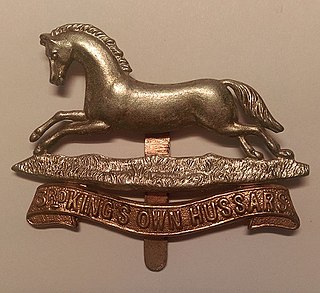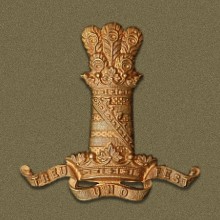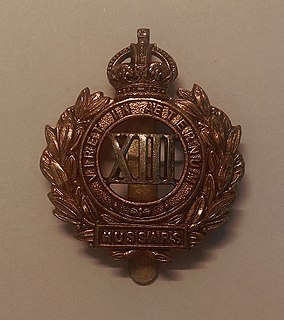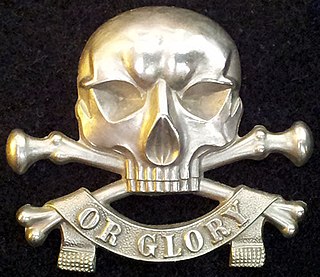 W
WThe Royal Dragoons was a mounted infantry and later a heavy cavalry regiment of the British Army. The regiment was formed in 1661 as the Tangier Horse. It served for three centuries and was in action during the First and the Second World Wars. It was amalgamated with the Royal Horse Guards to form The Blues and Royals in 1969.
 W
WThe Royal Scots Greys was a cavalry regiment of the British Army from 1707 until 1971, when they amalgamated with the 3rd Carabiniers to form The Royal Scots Dragoon Guards.
 W
WThe 6th (Inniskilling) Dragoons was a cavalry regiment in the British Army, first raised in 1689 as Sir Albert Cunningham's Regiment of Dragoons. One of the regiment's most notable battles was the Battle of the Boyne in July 1690. It became the 6th (Inniskilling) Regiment of Dragoons in 1751. The regiment also fought with distinction in the Charge of the Union Brigade at the Battle of Waterloo and again as part of the successful Charge of the Heavy Brigade against superior numbers at the Battle of Balaclava during the Crimean War. The First World War sounded the death knell for mounted cavalry as it became apparent that technology had moved forward with greater destructive power and made horsed cavalry redundant on the modern battlefield. The British Army reorganised and reduced its cavalry corps by disbanding or amalgamating many of its famous cavalry regiments. The Inniskillings was one of those affected. It saw service for two centuries, including the First World War, before being amalgamated with 5th Dragoon Guards to form 5th/6th Dragoons in 1922.
 W
WThe 1st King's Dragoon Guards was a cavalry regiment in the British Army. The regiment was raised by Sir John Lanier in 1685 as the 2nd Queen's Regiment of Horse, named in honour of Queen Mary, consort of King James II. It was renamed the 2nd King's Own Regiment of Horse in 1714 in honour of George I. The regiment attained the title 1st King's Dragoon Guards in 1751. The regiment served as horse cavalry until 1937 when it was mechanised with light tanks. The regiment became part of the Royal Armoured Corps in 1939. After service in the First World War and the Second World War, the regiment amalgamated with the 2nd Dragoon Guards in 1959 to form the 1st The Queen's Dragoon Guards.
 W
WThe 2nd Dragoon Guards was a cavalry regiment of the British Army. It was first raised in 1685 by the Earl of Peterborough as the Earl of Peterborough's Regiment of Horse by merging four existing troops of horse.
 W
WThe 3rd Dragoon Guards was a cavalry regiment in the British Army, first raised in 1685 as the Earl of Plymouth's Regiment of Horse. It was renamed as the 3rd Regiment of Dragoon Guards in 1751 and the 3rd Dragoon Guards in 1765. It saw service for two centuries, including the First World War, before being amalgamated into the 3rd/6th Dragoon Guards in 1922.
 W
WThe 4th Royal Irish Dragoon Guards was a cavalry regiment in the British Army, first raised in 1685 as the Earl of Arran's Regiment of Cuirassiers. It was renamed as the 4th Dragoon Guards in 1788 and service for two centuries, including the First World War, before being amalgamated with 7th Dragoon Guards, to form the 4th/7th Dragoon Guards in 1922.
 W
WThe 5th Dragoon Guards was a British army cavalry regiment, officially formed in January 1686 as Shrewsbury's Regiment of Horse. Following a number of name changes, it became the 5th Regiment of Dragoon Guards in 1804.
 W
WThe Carabiniers was a cavalry regiment of the British Army. It was formed in 1685 as the Lord Lumley's Regiment of Horse. It was renamed as His Majesty's 1st Regiment of Carabiniers in 1740, the 3rd Regiment of Horse (Carabiniers) in 1756 and the 6th Regiment of Dragoon Guards in 1788. After two centuries of service, including the First World War, the regiment was amalgamated with the 3rd Dragoon Guards to form the 3rd/6th Dragoon Guards in 1922.
 W
WThe 7th Dragoon Guards was a cavalry regiment in the British Army, first raised in 1688 as Lord Cavendish's Regiment of Horse. It was renamed as the 7th Dragoon Guards for Princess Charlotte in 1788. It saw service for two centuries, including the First World War, before being amalgamated with the 4th Royal Irish Dragoon Guards, to form the 4th/7th Dragoon Guards in 1922.
 W
WThe 3rd Hussars was a cavalry regiment of the British Army, first raised in 1685. It saw service for three centuries, including the First World War and the Second World War, before being amalgamated with the 7th Queen's Own Hussars, to form the Queen's Own Hussars in November 1958.
 W
WThe 4th Queen's Own Hussars was a cavalry regiment in the British Army, first raised in 1685. It saw service for three centuries, including the First World War and the Second World War. It amalgamated with the 8th King's Royal Irish Hussars, to form the Queen's Royal Irish Hussars in 1958.
 W
WThe 7th Queen's Own Hussars was a cavalry regiment in the British Army, first formed in 1689. It saw service for three centuries, including the First World War and the Second World War. The regiment survived the immediate post-war reduction in forces, but following the 1957 Defence White Paper, it was amalgamated with the 3rd The King's Own Hussars, forming the Queen's Own Hussars in 1958.
 W
WThe 8th King's Royal Irish Hussars was a cavalry regiment in the British Army, first raised in 1693. It saw service for three centuries including the First and Second World Wars. The regiment survived the immediate post-war reduction in forces, and went on to distinguish itself in the battles of the Korean War, but was recommended for amalgamation in the 1957 Defence White Paper prepared by Duncan Sandys. The regiment was amalgamated with the 4th Queen's Own Hussars, to form the Queen's Royal Irish Hussars in 1958.
 W
WThe 10th Royal Hussars was a cavalry regiment of the British Army raised in 1715. It saw service for three centuries including the First World War and Second World War but then amalgamated with the 11th Hussars to form the Royal Hussars in October 1969.
 W
WThe 11th Hussars was a cavalry regiment of the British Army established in 1715. It saw service for three centuries including the First World War and Second World War but then amalgamated with the 10th Royal Hussars to form the Royal Hussars in 1969.
 W
WThe 13th Hussars was a cavalry regiment of the British Army established in 1715. It saw service for three centuries including the Napoleonic Wars, the Crimean War and the First World War but then amalgamated with the 18th Royal Hussars, to form the 13th/18th Royal Hussars in 1922.
 W
WThe 14th King's Hussars was a cavalry regiment in the British Army, first raised in 1715. It saw service for two centuries, including the First World War, before being amalgamated with the 20th Hussars to form the 14th/20th King's Hussars in 1922.
 W
WThe 15th The King's Hussars was a cavalry regiment in the British Army. First raised in 1759, it saw service over two centuries, including the First World War, before being amalgamated with the 19th Royal Hussars into the 15th/19th The King's Royal Hussars in 1922.
 W
WThe 18th Royal Hussars was a cavalry regiment of the British Army, first formed in 1759. It saw service for two centuries, including the First World War before being amalgamated with the 13th Hussars to form the 13th/18th Royal Hussars in 1922.
 W
WThe 19th Royal Hussars was a cavalry regiment of the British Army, created in 1858. After serving in the First World War, it was amalgamated with the 15th The King's Hussars to form the 15th/19th The King's Royal Hussars in 1922.
 W
WThe 20th Hussars was a cavalry regiment of the British Army. After service in the First World War it was amalgamated with the 14th King's Hussars to form became the 14th/20th King's Hussars in 1922.
 W
WThe 5th Royal Irish Lancers was a cavalry regiment of the British Army. It saw service for three centuries, including the First World War. It amalgamated with the 16th The Queen's Lancers to become the 16th/5th Lancers in 1922.
 W
WThe 9th Queen's Royal Lancers was a cavalry regiment of the British Army, first raised in 1715. It saw service for three centuries, including the First and Second World Wars. The regiment survived the immediate post-war reduction in forces, but was amalgamated with the 12th Royal Lancers to form the 9th/12th Royal Lancers in 1960.
 W
WThe 12th Royal Lancers was a cavalry regiment of the British Army first formed in 1715. It saw service for three centuries, including the First World War and the Second World War. The regiment survived the immediate post-war reduction in forces, but was slated for reduction in the 1957 Defence White Paper, and was amalgamated with the 9th Queen's Royal Lancers to form the 9th/12th Royal Lancers in 1960.
 W
WThe 16th The Queen's Lancers was a cavalry regiment of the British Army, first raised in 1759. It saw service for two centuries, before being amalgamated with the 5th Royal Irish Lancers to form the 16th/5th Lancers in 1922.
 W
WThe 17th Lancers was a cavalry regiment of the British Army, raised in 1759 and notable for its participation in the Charge of the Light Brigade during the Crimean War. The regiment was amalgamated with the 21st Lancers to form the 17th/21st Lancers in 1922.
 W
WThe 21st Lancers was a cavalry regiment of the British Army, raised in 1858 and amalgamated with the 17th Lancers in 1922 to form the 17th/21st Lancers. Perhaps its most famous engagement was the Battle of Omdurman, where Winston Churchill, rode with the unit.
 W
WThe 1st Regiment of Life Guards was a cavalry regiment in the British Army, part of the Household Cavalry. It was formed in 1788 by the union of the 1st Troop of Horse Guards and 1st Troop of Horse Grenadier Guards. In 1922, it was amalgamated with the 2nd Life Guards to form the Life Guards.
 W
WThe 2nd Regiment of Life Guards was a cavalry regiment in the British Army, part of the Household Cavalry. It was formed in 1788 by the union of the 2nd Troop of Horse Guards and 2nd Troop of Horse Grenadier Guards. In 1922, it was amalgamated with the 1st Life Guards to form the Life Guards.
 W
WThe Royal Regiment of Horse Guards (RHG) was a cavalry regiment of the British Army, part of the Household Cavalry.